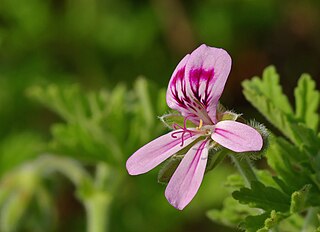
Ruta is a genus of strongly scented evergreen subshrubs, 20–60 cm tall, in the family Rutaceae, native to the Mediterranean region, Macaronesia and southwest Asia. There are perhaps 8 to 40 species in the genus. The most well-known species is Ruta graveolens.

Ruta graveolens [L. strong smelling rue], commonly known as rue, common rue or herb-of-grace, is a species of Ruta grown as an ornamental plant and herb. It is native to the Balkan Peninsula. It is now grown throughout the world in gardens, especially for its bluish leaves, and sometimes for its tolerance of hot and dry soil conditions. It is also cultivated as a medicinal herb, as a condiment, and to a lesser extent as an insect repellent.

Apium is a genus of about 20 species of flowering plants in the family Apiaceae, with a subcosmopolitan distribution in Europe, Asia, Africa, South America and Australia. They are medium to tall biennials or perennials growing up to 1 m high in the wet soil of marshes and salt marshes, and have pinnate to bipinnate leaves and small white flowers in compound umbels. Some species are edible, notably Apium graveolens, which includes the commercially important vegetables celery, celeriac and Chinese celery. Apium bermejoi from the island of Menorca is one of the rarest plants in Europe, with fewer than 100 individuals left.

Leaf celery, also called Chinese celery or Nan Ling celery, is a variety of celery cultivated in East Asian countries for its edible, flavorful stalks and leaves.

Pelargonium graveolens is an uncommon Pelargonium species native to the Cape Provinces and the Northern Provinces of South Africa, Zimbabwe and Mozambique. It is in the subgenus Pelargonium along with Pelargonium crispum, Pelargonium tomentosum and Pelargonium capitatum.

Lippia is a genus of flowering plants in the verbena family, Verbenaceae. It was named after Augustus Lippi, (1678-1705), a French naturalist and botanist. He was killed in Abyssinia. The genus contains roughly 200 species of tropical shrubs that are found around the world. Plants are fragrant due to their essential oils, which vary between species but may include estragole, carvacrol, linalool, or limonene. The leaves of certain species, such as L. graveolens, can be used as a culinary herb similar to oregano.

Globifomes is a fungal genus in the family Polyporaceae. It is a monotypic genus, containing the single North American species Globifomes graveolens, commonly known as sweet knot. This fungus is found fruiting singly or in groups on trunks or logs of hardwood trees, primarily oaks. The fruit body consists of a mass of small overlapping hoof-shaped caps arising from a common core. It is initially dull yellow-brown with tan petal-shaped margins, aging to dark brown.

Phalonidia contractana is a moth of the family Tortricidae. It is found in southern Europe, Dalmatia, Macedonia, Hungary, Romania, Bulgaria, Greece, Ukraine, southern Russia (Sarepta), Uralsk, Turkey, Kuldscha, Afghanistan, Kashmir, Lebanon, China, Iran, Pakistan and Kyrgyzstan.

Inula salicina is a plant species in the genus Inula in the family Asteraceae. It is found across Europe and Asia from Portugal to Japan. It has been reported growing in the wild in a few scattered locations in North America but it has not become widely established there.

Inula britannica, the British yellowhead or meadow fleabane, is a Eurasian species of plant in the genus Inula within the daisy family. It is widespread across much of Europe and Asia, and sparingly naturalized in scattered locations in North America.

Dittrichia viscosa, also known as false yellowhead, woody fleabane, sticky fleabane and yellow fleabane, is a flowering plant in the daisy family.

Inula spiraeifolia is a European species perennial herbaceous plant belonging to the genus Inula within the daisy family.
Hellinsia inulae is a moth of the family Pterophoridae. It is found on the Canary Islands, Iberian Peninsula, Corsica, Sardinia, Sicily, Cyprus and in Germany, Austria, Italy, the Czech Republic, Poland, Slovakia, Hungary, Croatia, Romania, Bulgaria, Bosnia and Herzegovina, the Republic of Macedonia, Greece, Russia, North Africa and Asia Minor.

Harmankaya Nature Park is a nature park located in Termal district of Yalova Province, northwestern Turkey.

Durio graveolens, sometimes called the red-fleshed durian, orange-fleshed durian, or yellow durian, is a species of tree in the family Malvaceae. It is one of six species of durian named by Odoardo Beccari. The specific epithet graveolens is due to the odor, although most species of Durio have a strong scent, the red-fleshed type of D. graveolens has very little scent.
D. graveolens may refer to two different plant species. The specific epithet graveolens means 'pungent.'
















